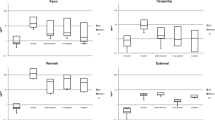Abstract
A factory survey was conducted in the second half of a working week on 41 exposed male workers, who were engaged in fiber-reinforced plastics work and exposed to the mixed vapors of styrene and acetone. Nonexposed workers, 20 men, were recruited from the same factory. Styrene and acetone in respiratory zone air were monitored for a 8-h shift with carbon cloth- and water-equipped personal diffusive samplers, respectively. Blood and urine samples were collected at the shift-end. Acetone and styrene concentrations in whole blood, serum and urine were measured by head-space gas chromatography, and phenylglyoxylic acid in urine by high-performance liquid chromatography. All biological exposure indicators analyzed correlated significantly with the intensity of exposure to the corresponding solvent during the shift. The slopes of the regression lines indicate that a very small fraction of styrene absorbed will be excreted into urine as styrene per se, and that styrene is quite effectively excreted into urine after metabolic conversion. In contrast, the slopes of regression lines for acetone suggest that acetone distributes both in the blood and urine quite evenly. When the distribution of the solvent in serum was compared with that in the whole blood, it was found that almost all of styrene in blood is present in the serum, whereas acetone distributed very evenly in the cellular and noncellular fractions of the blood.
Similar content being viewed by others
References
American Conference of Governmental Industrial Hygienists (1992) Threshold limit values and biological exposure indices for 1992–1993. ACGIH, Cincinnati, OH
Deutsche Forschungsgemeinschaft (1991) Maximum concentrations at the workplace and biological tolerance values for working materials 1991. VCH, Weinheim
Hirayama T, Ikeda M (1979) Applicability of carbon felt to the dosimetry of solvent vapor mixture. Am Ind Hyg Assoc J 40:1091–1096
Ikeda M, Koizumi A, Miyasaka M, Watanabe T (1982) Styrene exposure and biological monitoring in FRP boat production plants. Int Arch Occup Environ Health 49:325–339
Ikeda M, Hara I (1980) Evaluation of exposure to organic solvents by means of urinalysis for metabolites. Jpn J Ind Health 22:3–17 (in Japanese with English abstract)
Inoue O, Seiji K, Nakatsuka H, Watanabe T, Yin S-N, Li G-L, Cai S-X, Jin C, Ikeda M (1989) Urinary t,t-muconic acid as an indicator of exposure to benzene. Br J Ind Med 46:122–127
Inoue O, Seiji K, Suzuki T, Watanabe T, Nakatsuka H, Satoh H, Ikeda M (1991) Simultaneous determination of hippuric acid, o-, m-, and p-methylhippuric acid, phenylglyoxylic acid, and mandelic acid by HPLC. Bull Environ Contam Toxicol 47:204–210
Jackson S (1966) Creatinine in urine as an index of urinary excretion rate. Health Phys 12:843–850
Japan Association of Industrial Health (1992) Recommended occupational exposure limits. Jpn J Ind Health 34:363–384
Kawai T, Mizunuma K, Yasugi T, Horiguchi S, Uchida Y, Iwami O, Iguchi H, Ikeda M (1991) Urinary methylhippuric acid isomer levels after occupational exposure to a xylene mixture. Int Arch Occup Environ Health 63:69–75
Kawai T, Yasugi T, Mizunuma K, Horiguchi S, Morioka I, Miyashita K, Uchida Y, Ikeda M (1992a) Monitoring of workers exposed to a mixture of toluene, styrene and methanol vapours by means of diffusive air sampling, blood analysis and urinalysis. Int Arch Occup Environ Health 63:429–435
Kawai T, Yasugi T, Mizunuma K, Horiguchi S, Iguchi H, Ikeda M (1992b) Curvi-linear relation between acetone in breathing zone air and acetone in urine among workers exposed to acetone vapor. Toxicol Lett 62:85–91
Lam C-W, Galen TJ, Boyd JF, Pierson DL (1990) Mechanism of transport and distribution of organic solvents in blood. Toxicol Appl Pharmacol 104:117–129
Lauwerys R (1984) Styrene. In: Alessio L, Berlin A, Boni M, Roi R (eds) Biological indicators for the assessment of human exposure to industrial chemicals. CEC Joint Research Centre Ispra Istablishment, pp 67–80
Pang YC, Reid PE, Brooks DE (1980) Solubility and distribution of halothane in human blood. Br J Anaesth 52:851–862
Rainsford SG, Lloyd Davies TA (1965) Urinary excretion of phenol by men exposed to vapour of benzene: A screening test. Br J Ind Med 22:21–26
Uchida Y, Kawai T, Yasugi T, Ikeda M (1990) Personal monitoring sampler for acetone vapor exposure. Bull Environ Contam Toxicol 44:900–904
Author information
Authors and Affiliations
Rights and permissions
About this article
Cite this article
Mizunuma, K., Yasugi, T., Kawai, T. et al. Exposure-excretion relationship of styrene and acetone in factory workers: A comparison of a lipophilic solvent and a hydrophilic solvent. Arch. Environ. Contam. Toxicol. 25, 129–133 (1993). https://doi.org/10.1007/BF00230723
Received:
Revised:
Issue Date:
DOI: https://doi.org/10.1007/BF00230723




